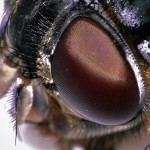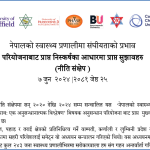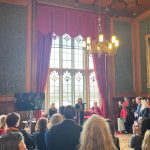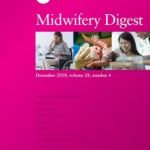
“Blood feeding activity of flies at crime scenes can be confounding. Experiments were conducted to investigate the blood feeding activity, and blood artefact patterns created by flies following a blood meal. The trials were undertaken in a staged environment where over 500 flies were exposed to 500ml of horse blood in a sealed gazebo for a period of 72 hours. The resulting patterns, a total of 539,507 fly blood artefacts, were then compared to recreated bloodstain patterns commonly encountered during instances of violent assault. These comparisons focused on overall pattern shape, total stain numbers, stain density per cm2 and the zone where they were deposited. Informal observations and recordings were also made of individual stain colour and stain alignment, but were not measured.”
This was the abstract submitted to accompany Christopher’s recent submission to the Research Photography Competition, where he won second prize.
 Photo of the Week: The Compound Eye of Calliphora Vomitoria (a bluebottle fly)
Photo of the Week: The Compound Eye of Calliphora Vomitoria (a bluebottle fly)










 Writing policy briefs
Writing policy briefs Upholding Excellence: The Concordat to Support Research Integrity
Upholding Excellence: The Concordat to Support Research Integrity Today’s Documentation Will Serve Tomorrow’s Justice
Today’s Documentation Will Serve Tomorrow’s Justice Up2U: New BU academic publication
Up2U: New BU academic publication New BU midwifery paper
New BU midwifery paper ECR Funding Open Call: Research Culture & Community Grant – Application Deadline Friday 12 December
ECR Funding Open Call: Research Culture & Community Grant – Application Deadline Friday 12 December MSCA Postdoctoral Fellowships 2025 Call
MSCA Postdoctoral Fellowships 2025 Call ERC Advanced Grant 2025 Webinar
ERC Advanced Grant 2025 Webinar Horizon Europe Work Programme 2025 Published
Horizon Europe Work Programme 2025 Published Horizon Europe 2025 Work Programme pre-Published
Horizon Europe 2025 Work Programme pre-Published Update on UKRO services
Update on UKRO services European research project exploring use of ‘virtual twins’ to better manage metabolic associated fatty liver disease
European research project exploring use of ‘virtual twins’ to better manage metabolic associated fatty liver disease